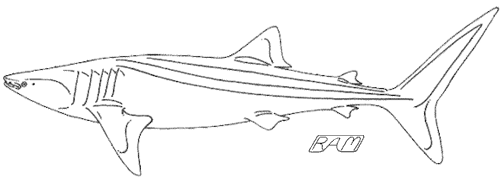Giants: Whale Shark
(Rhincodon typus)
Maximum Length = 50 feet (15.2 metres)
Maximum Weight = 13 tons (12 tonnes)*

This gigantic creature is the largest living shark as well as the largest living fish of any kind. The Whale Shark is, in fact, as large or larger than most cetaceans and only a few whales grow larger. It sports one of the most distinctive pigmentation patterns in Nature, being greyish, bluish, or brownish above and covered with a geometric pattern of whitish spots and vertical bars that has earned it the nick-name "checkerboard shark". The Whale Shark has the thickest skin of any animal, measuring up to 6 inches (15 centimetres) thick on the back. It is generally not aggressive toward humans, being a filter-feeder that has huge, spongy plates inside its gill slits and only tiny teeth arranged in over 300 rows (its genus name, Rhincodon, means "rasp tooth"). The Whale Shark often assumes a vertical orientation while feeding, relying on a combination of up-and-down 'pumping' in the water column and oro-pharyngeal suction to capture food. This combination renders the Whale Shark more versatile than most filter-feeders, preying heavily on small planktonic organisms as well as larger creatures up to and including small tunas. The Whale Shark is found throughout the world in tropical waters, sometimes venturing into colder water at higher latitudes during summer months. Recent tagging and telemetry studies indicate that it is a highly nomadic species, individuals apparently following plankton blooms around their native ocean basin. For example, in the 1990's, it was discovered that large numbers of Whale Sharks congregate each March and April at Ningaloo Reef, off the coast of Western Australia, apparently to feed on the coral eggs and other small creatures whose populations bloom in response to the mass coral spawning that occurs annually at that time. Until recently, it was thought that the Whale Shark was an egg-layer, based on a single egg case found in 1955. But in 1995, a pregnant Whale Shark was harpooned off Taiwan that contained over 300 perfectly formed pups, apparently ready to be born alive. This is the largest litter size known for any species of shark.
* 1 ton = 2,000 pounds: 1 tonne = 1,000 kilograms
